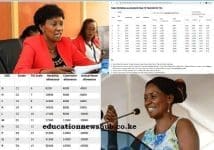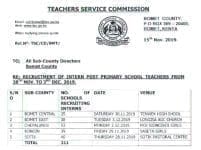
The Teachers Service Commission, TSC, updates the rates of allowances paid to teachers from time to time. After a TSC promotion, the allowances are adjusted accordingly as per the recent Job Group (Grade). All teachers receive different types of allowances from TSC. These allowances are paid to teachers alongside their monthly salaries.
Allowances paid by TSC depend on such factors as the work station, job grade of individual teachers, responsibilities and others like type of learners handled. See table showing all the TSC allowances per job group at the bottom of this post.
Whereas most allowances are paid on a monthly basis, others are one off. Below is a description of the various types of allowances paid by TSC.
Types of allowances paid to teachers
Allowances paid to teachers are classified as either remunerative or reimbursable.
Remunerative allowances are paid with salary while reimbursable allowances are refundable upon application.
A. Remunerative allowances
There are two types of remunerative allowances;
-
- Automatic
- Those paid upon application
I. Automatic allowances include:
- house
- medical (No longer paid to teachers; deducted and paid directly to Minet insurance and another is given to the NHIF)
- commuter
- hardship
- Leave allowance
HOUSE ALLOWANCE
House allowance is paid on a monthly basis to all teachers. It is paid on two criteria; Job grade and workstation. Teachers in higher job groups earn a higher house allowance than those in lower cadres. The salaries and remuneration commission, src, has also clustered teachers’ work station into four regions;
- Nairobi,
- Former Major Municipalities (Mombasa, Kisumu, Nakuru, Nyeri, Eldoret, Thika, Kisii, Malindi and Kitale),
- Other former Municipalities; Ruiru, Kikuyu, Kitui, Machakos, Mlolongo, Athi River, Vihiga, Wote, Mumias, Bomet, Limuru, Kericho, Kimilili, Kakamega, Kapsabet, Kiambu, Bungoma, Webuye, Busia, Runyenjes, Migori, Embu, Homa Bay, Lodwar, Meru, Nyahururu, Nanyuki, Maua, Voi, Siaya, Chuka and Kerugoya/ Kutus
- Other areas; this include all regions not mentioned in bullet 1-3 above.
Teachers working in Nairobi draw the largest amount of house allowance whereas those plying their trade in reserves (other areas) receive the lowest amounts. (Details on the table at the bottom end of this article).
Here is your complete guide to all the new teachers’ salary scales. Click on this link.
HARDSHIP ALLOWANCE
TSC pays monthly hardship allowance to teachers working in areas prone to insecurity, high risks and harsh climatic conditions. The commission has designated various areas as hardship. The allowance is paid according to a teacher’s grade. Those in higher job grades earn more than their counterparts in lower cadres. (see table below; bottom end of the article).
COMMUTER ALLOWANCE
Commuter allowance is paid to all teachers on a monthly basis. Payment of this allowance is solely dependent on the teacher’s job group. (See tabulated figures below; scroll to the bottom of the page)
LEAVE ALLOWANCE
Leave allowance is a yearly allowance paid together with the January Salary of the preceding year. It is given as per a teacher’s grade; with those in higher job grades earning more.
Posts with related news;
TSC teacher promotions and new salaries 2021
TSC administrative promotions 2021 lists (How to check if you have been promoted)
TSC list of all appointed Senior Teachers per county: Latest TSC News
TSC reveals criteria used to promote teachers in 2021 (See promotion lists per County and letters)
2021 TSC Promotion results and letters for over 16,000 teachers out
TSC says Promotions of teachers completed (Letters to be dispatched)
B. Allowances paid on application include:
a. Responsibility allowance
This is paid to headteachers,deputy headteachers and senior teachers who are at Job Group K and below.
b. Special duty allowance
This is payable to teachers below job group M appointed to administrative posts by commission and deployed in arid and semi-arid lands.
c. Readers allowance
This is paid to a visually impaired teacher who has engaged a reader whose minimum qualification is not below KCSE D+/KCE Division III. The allowance is paid at a fixed rate determined from time to time by the commission.
Also called facilitation or aid allowance, reader’s allowance is paid at a rate of Sh15,000 per month to the blind teachers and those confined to wheel chairs by virtue of their disability.
d. Interpreters Allowance
This is payable to deaf teachers who engage interpreters while on study leave. Special school allowance -This is paid to teachers specialized in special needs education and who have been deployed to teach in special schools or units.
e. Transfer Allowance
This is payable to teachers who have been transferred from one workstation to another, provided the transfer is initiated by the Commission. It is equivalent to a teacher’s basic pay for one month.
B. Reimbursable Expenses
The commission reimburses the following expenses to teachers
I. Travelling expenses:
The teacher is eligible for reimbursement only in the following circumstances;
- Where a teacher’s interdiction has been revoked.
- While traveling to attend an interview
- Travelling to a station on first posting outside home District
- Traveling from duty station outside home District on retirement
- Teachers working in hardship areas travelling to and from home during school holidays.The teacher’s home District must be outside the hardship area.
Teachers should apply on prescribed forms attaching supporting documents.
II. Quota per diem:
This is daily subsistence allowance paid to teachers on official assignment. Application must be made at least 14 days before travelling.
TABLE SHOWING ALLOWANCES PAID TO TEACHERS BY TSC.
| S/NO | GRADEJOB
GROUP |
COMMUTER | LEAVE | HARDSHIP | HOUSE ALLOWANCE educationnewshub.co.ke | LOCAL TRAVEL educationnewshub.co.ke | |||||
| Nairobi | Major municipalities* | Other municipalities* | others | Cluster 1* | Cluster2* | Cluster 3* | |||||
| 1 | B5 | 4,000 | 4,000 | 6,600 | 6,750 | 4,500 | 3,850 | 3,200 | 6,300 | 4,900 | 4,200 |
| 2 | C1 | 4,000 | 4,000 | 8,200 | 10,000 | 7,500 | 5,800 | 4,200 | 6,300 | 4,900 | 4,200 |
| 3 | C2 | 5,000 | 6,000 | 10,900 | 16,500 | 12,800 | 9,600 | 7,500 | 11,200 | 8,400 | 7,000 |
| 4 | C3 | 6,000 | 6,000 | 12,300 | 28,000 | 22,000 | 16,500 | 13,000 | 11,200 | 8,400 | 7,000 |
| 5 | C4 | 8,000 | 6,000 | 14,650 | 28,000 | 22,000 | 16,500 | 13,000 | 11,200 | 8,400 | 7,000 |
| 6 | C5 | 8,000 | 6,000 | 17,100 | 35,000 | 25,500 | 18,000 | 20,000 | 11,200 | 8,400 | 7,000 |
| 7 | D1 | 12,000 | 10,000 | 27,300 | 45,000 | 28,000 | 25,000 | 20,000 | 14,000 | 10,500 | 8,400 |
| 8 | D2 | 13,000 | 10,000 | 30,000 | 50,000 | 35,000 | 25,000 | 20,000 | 14,000 | 10,500 | 8,400 |
| 9 | D3 | 14,000 | 10,000 | 32,700 | 50,000 | 35,000 | 25,000 | 20,000 | 14,000 | 10,500 | 8,400 |
| 10 | D4 | 15,000 | 10,000 | 35,400 | 50,000 | 35,000 | 25,000 | 20,000 | 14,000 | 10,500 | 8,400 |
| 11 | D5 | 16,000 | 10,000 | 38,100 | 50,000 | 35,000 | 25,000 | 20,000 | 14,000 | 10,500 | 8,400 |
Key:
- Former Major Municipalities* include: Mombasa, Kisumu, Nakuru, Nyeri, Eldoret, Thika, Kisii, Malindi and Kitale.
- Other former Municipalities* are: Ruiru, Kikuyu, Kitui, Machakos, Mlolongo, Athi River, Vihiga, Wote, Mumias, Bomet, Limuru, Kericho, Kimilili, Kakamega, Kapsabet, Kiambu, Bungoma, Webuye, Busia, Runyenjes, Migori, Embu, Homa Bay, Lodwar, Meru, Nyahururu, Nanyuki, Maua, Voi, Siaya, Chuka and Kerugoya/ Kutus.
- Cluster 1* include: Nairobi, Mombasa, Kisumu, Malindi, Kilifi, Lamu, Kwale and Naivasha.
- Cluster 2*: Nyeri, Eldoret, Kericho, Kakamega, Kisii, Embu, Nanyuki, Nakuru, Lodwar and Garissa.





